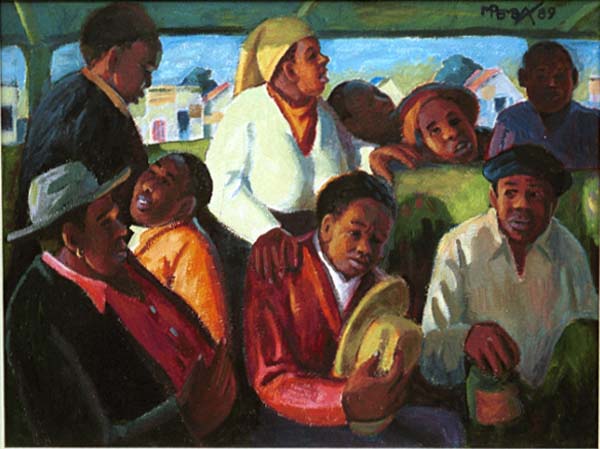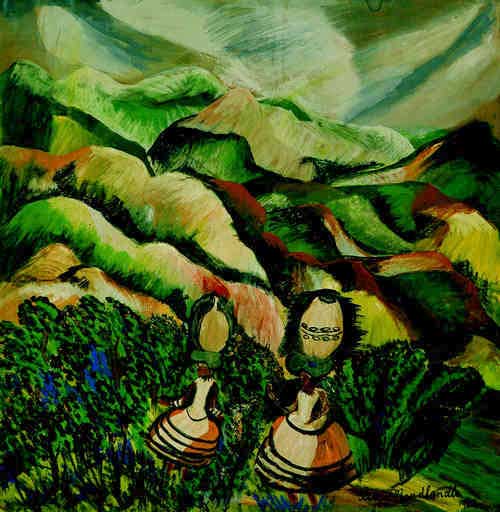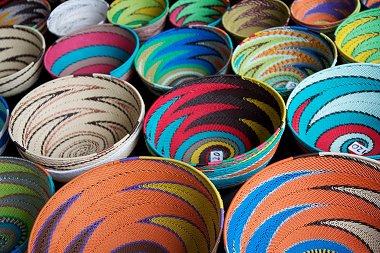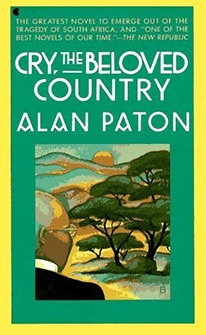As the
Khoisan and San people moved into the southernmost parts of Africa where the
Bantu and Nguni people came before them, they brought along their own art forms
and culture. The earliest nomadic tribes left evidence of their existence
through their rock paintings depicting their life and even their magical
beliefs. The paints they used were created from local plants and other materials,
giving them an array of reds, blacks, greys, whites, and yellows.
In the
indigenous communities, art remained a functional part of their society. Like
many similar cultures, their folk art came in the forms of small sculptures,
jewelry, pottery, baskets, and other handicrafts. However, most of what is made
now is only to appease the tourist markets.
 |
| by George Pemba |
During
the 20th century, South African artists began to take on subjects
related to their national and ancestral identity, in contrast to the
colonialism they just came out from under. Art was also used as a way of
dealing with their socio-political problems, like apartheid. Some names to know
are Moses Tladi (in 1938, he became
the first black artist to formally exhibit his work), Qwabe brothers (known for their relief carvings), Hezekiel Ntuli (known for his
sculptures, especially oxen, leopards, and portrait busts), Gerard Bengu (known for his realistic
paintings of rural Bhaca life and landscapes), George Pemba (one of the pioneers of black artists, part of the
“Thirties Generation,” won numerous awards for his work spanning seven decades),
John Koenakeefe Mohl (painter, also
started the first art school for black artists), Gladys Mgudlandlu (self-taught artist, first black woman to have
her work displayed in a gallery), and Simon
Lekgetho (known for his often haunting depictions of African life and
cultural items).
 |
| by Gladys Mgudlandlu |
It's great to live in a diverse area. It makes us all richer. However,
when your country's borders were drawn by someone else, it can cause some
cultural issues. South Africa has 11 official languages and a number of other
locally spoken ones. Literature from this country can be found written in
English, Afrikaans, Xhosa, Zulu, Pedi, Sotho, Venda, Tswana, Tsonga, Ndebele,
or SiSwati. However, these languages and cultures spread across borders, so
someone can write in Tswana but not necessarily live in South Africa. Sometimes,
it brings up questions of nationality versus culture.
Because English is often used as the lingua franca in South Africa and holds status as an international language, there is quite a bit of South African literature written in English. One of the first major works written in English from South Africa was The Story of an African Farm by Olive Schreiner, published in 1883. However, by far the most widely read South African work (in American classrooms, at least) is Alan Paton's Cry, The Beloved Country, published in 1948. Some English-language authors of note include Nadine Gordimer (anti-apartheid political activist, winner of the Booker Prize in 1974 and the Nobel Prize in Literature in 1991), J.M. Coetzee (won the Booker Prize in both 1983 and 1999 as well as the Nobel Prize in Literature in 2003 and others), Miriam Tlali (first black woman to have a novel published, which was in 1975), and Zakes Mda (poet, playwright, novelist, won the Commonwealth Writers Prize in 2001 and is part of the school curriculum) among many others.
Afrikaans literature makes up another large portion of the literature from South Africa. The Afrikaans language is similar to Dutch but obviously has a lot of African and German words thrown in the mix. It's spoken throughout the land and also serves as a lingua franca among both whites and coloured South Africans. [In South Africa, coloured refers to mixed race people, not the archaic derogatory meaning it has in the US -- it still throws me off when I see it). One of the more prominent literary styles that was popular was the plaasroman, or farm novel; and likewise as urbanization became to take hold post-WWII, the dorpsroman, or town novel developed the same way. Some of the more well-known Afrikaans-language authors (and some also write in English as well) include Andre Brink, Eben Venter, Marlene van Niekerk, Lettie Viljoen, Breyten Breytenbach, and Etienne van Heerden.
And now we come to African language literature. There is a difference in subject matter and perhaps tone between white and black South African authors. Racial differences sometimes set boundaries in literature. Many black authors write using the apartheid period as the backdrop and often write on their history, the consequences of colonialism, and other epidemics. And while the early part of the 20th century was clearly dominated by male writers, female authors began to emerge and get published during the latter half. And even at that, it was hard for female authors to gain notoriety because of the long-established patriarchy. Black South African authors are generally categorized by the language they write in: Zulu (BW Vilakazi, Mazisi Kunene, HIE Dhlomo, RRR Dhlomo), Xhosa (SEK Mqhayi, AC Jordan, Godfrey Mzamane), Sesotho (Thomas Mofolo), and Tswana (Sol Plaatje, LD Raditladi).
Up next: music and dance





No comments:
Post a Comment